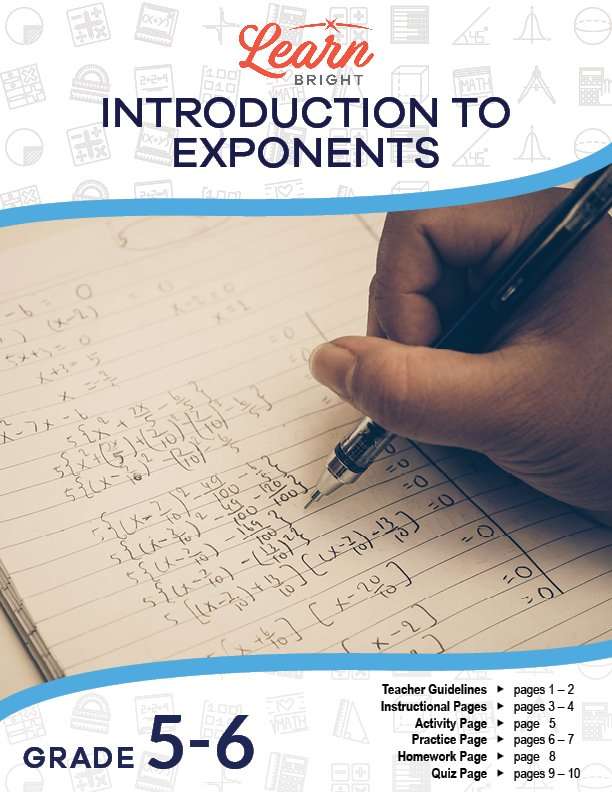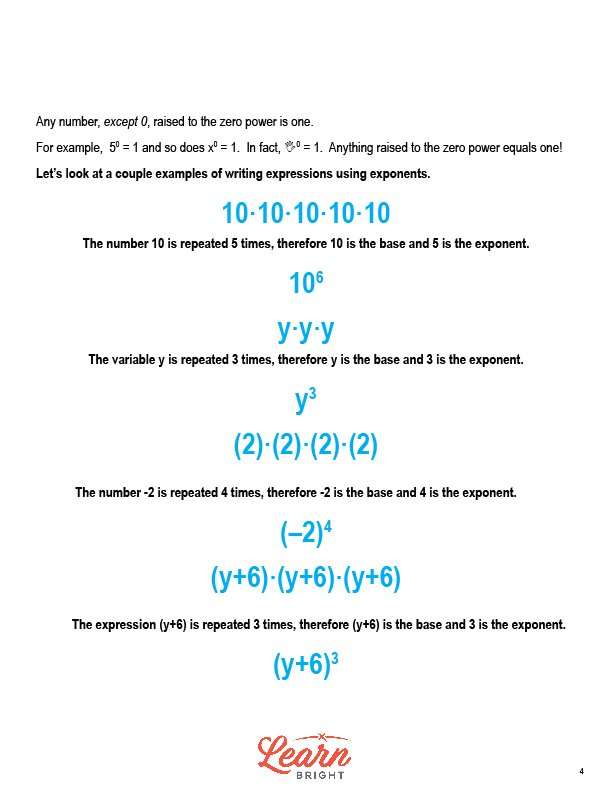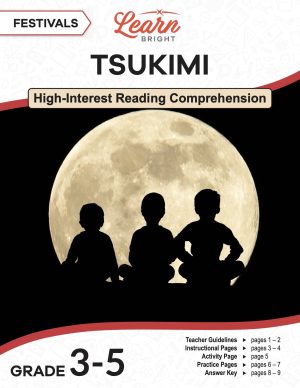Description
What our Introduction to Exponents lesson plan includes
Lesson Objectives and Overview: Introduction to Exponents defines relevant vocabulary like exponent, base, squared and cubed and teaches students the basics of how they’re used. Scientific notation is also introduced and practiced using the included activity sheets. At the end of the lesson, students will be able to identify, use, and solve exponents. The students will be able to use exponents for scientific notation. This lesson is for students in 5th grade and 6th grade.
Classroom Procedure
Every lesson plan provides you with a classroom procedure page that outlines a step-by-step guide to follow. You do not have to follow the guide exactly. The guide helps you organize the lesson and details when to hand out worksheets. It also lists information in the blue box that you might find useful. You will find the lesson objectives, state standards, and number of class sessions the lesson should take to complete in this area. In addition, it describes the supplies you will need as well as what and how you need to prepare beforehand.
Options for Lesson
Included with this lesson is an “Options for Lesson” section that lists a number of suggestions for activities to add to the lesson or substitutions for the ones already in the lesson. One optional addition to this lesson is to have your students roll dice to create a base and an exponent and then evaluate. You can also have students create their own problems and solve using a calculator. They can also learn how to use a calculator to solve exponents! Finally, if you’d like to expand this lesson, you can incorporate scientific notation into it as well.
Teacher Notes
The teacher notes page includes lines that you can use to add your own notes as you’re preparing for this lesson.
INTRODUCTION TO EXPONENTS LESSON PLAN CONTENT PAGES
Introduction to Exponents
The Introduction to Exponents lesson plan includes two pages of content. Exponents are essentially a shorthand for multiplication. For example, 5² = 5 x 5 and 5³ = 5 x 5 x 5. The exponent tells you how many times to multiply the number or variable (called the base). For 5³, 5 is the base and 3 is the exponent. Using an exponent is sometimes called raising a number or variable to a power, where the exponent is the power. We read 5³ as “five raised to the third power” or “five cubed”.
Often, when using numbers, we simplify them where possible. For example, we prefer the number 27 over 3³, even though the value is the same. However, when using variables, using the exponent is the simpler option. For example, x⁶ is easier to understand than xxxxxx.
You need to pay extra attention when working with negatives. For example, 5³ = 5 x 5 x 5 = 125, while -5³ = -(5 x 5 x 5) = -125 and (-5)³ = (-5) x (-5) x (-5) = -125. If you do not have a negative, you simply repeat the number or variable. If you do have a negative in front of the number with no parenthesis, this technically means that you do not need to repeat the negative. In the example, the negative is not repeated because it is not a part of the base. If the negative is inside of the parenthesis, then the number is negative and should be repeated as the base. All numbers other than zero raised to the zero power equals 1. For example, 5⁰ = 1 and x⁰ = 1.
Next, the lesson includes a few examples of writing expressions using exponents. First, 10 x 10 x 10 x 10 x 10 written with an exponent is 10⁵, because 10 is repeated 5 times. 10 is the base and 5 is the exponent. Next, y x y x y written with an exponent is y³, because the variable y is repeated 3 times. The base is y and the exponent is 3.
Next, (-2) x (-2) x (-2) x (-2) written with exponents is (-2)⁴ because (-2) is repeated 4 times. (-2) is the base and 4 is the exponent. Finally, (y + 6) x (y + 6) x (y + 6) written with an exponent is (y + 6)³, because the expression (y + 6) is repeated 3 times. The base is (y + 6) and the exponent is 3.
INTRODUCTION TO EXPONENTS LESSON PLAN WORKSHEETS
The Introduction to Exponents lesson plan includes three worksheets: an activity worksheet, a practice worksheet, and a homework assignment. You can refer to the guide on the classroom procedure page to determine when to hand out each worksheet.
PASTED PROBLEMS ACTIVITY WORKSHEET
The activity worksheet asks students to walk around and find different problems pasted around the classroom to solve. Students will solve all ten problems, working with their classmates when necessary.
INTRODUCTION TO EXPONENTS PRACTICE WORKSHEET
For the practice worksheet, students will first write expressions as products of repeated factors. Next, they will rewrite expressions using a single exponent. Finally, they will evaluate different expressions.
STORY OR SONG HOMEWORK ASSIGNMENT
The homework assignment asks students to choose between two exercises for the homework assignment. Their first option is to write a fictional story about exponents that includes information about what exponents are and how they work with a few illustrations. Their second option is to write a song about exponents with three unique verses that also includes information about exponents.
QUIZ
This lesson also includes a quiz that you can use to test students’ understanding of the lesson material. Like the practice worksheet, for the quiz, students will first write expressions as products of repeated factors. Next, they will rewrite expressions using a single exponent. Finally, they will evaluate different expressions.
Worksheet Answer Keys
This lesson plan includes answer keys for the practice worksheet and the quiz. If you choose to administer the lesson pages to your students via PDF, you will need to save a new file that omits these pages. Otherwise, you can simply print out the applicable pages and keep these as reference for yourself when grading assignments.









